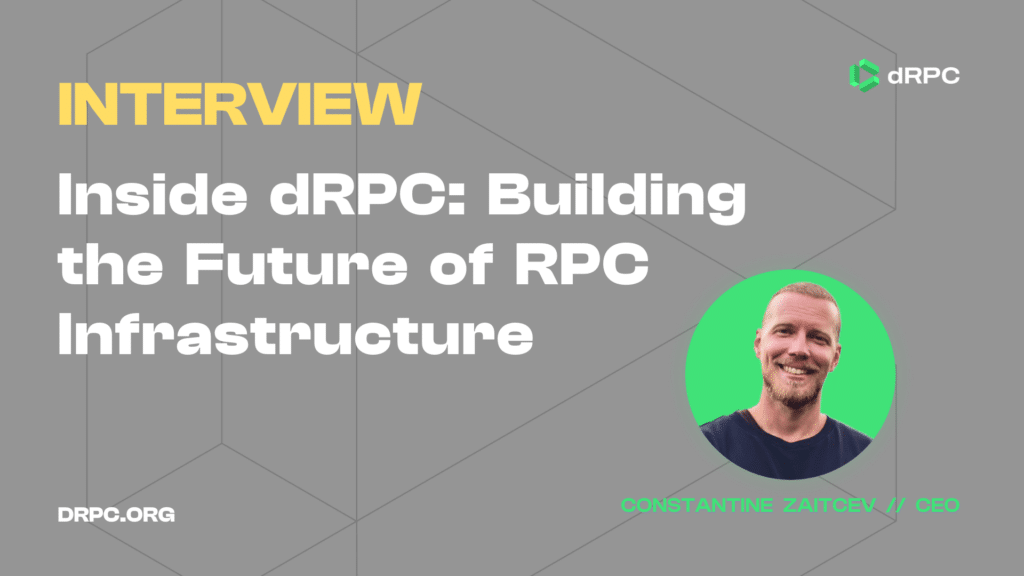Introduction
In this interview, I share my journey as the CEO of dRPC, an innovator in the Web3 space that is disrupting the RPC market by addressing the growing complexities of decentralized infrastructure. At dRPC, we’ve been at the forefront of solving RPC management issues, offering a unique approach to load balancing and data accuracy. I’ll discuss the origins of dRPC, the challenges we’ve tackled, and our vision for the future of RPC. As we continue to enhance our services, dRPC is positioning itself as a key player in shaping the future of RPC technology.
The Interview
1. Could you start by sharing a bit about yourselves and your journey through Web3? How did you get started?
My name is Constantine, and I’m the CEO of dRPC.org. I started as a tech guy, working as a DBA for several years before gradually moving to the business side. Before entering Web3, I held various roles in large financial and telecom companies, handling high-load systems like billing and antifraud systems. My Web3 journey began in 2015 when I joined Ambisafe, where we built white-label wallets, a semi-decentralized exchange, and other services. It was an exciting time as many well-known crypto companies were just getting started.
2. What drew you into blockchain technology?
I got involved in blockchain around 2015. At Ambisafe, we were working on projects like white-label wallets and decentralized exchanges. The innovation and the chance to work on something truly new fascinated me, and I could see early on that the future of RPC infrastructure would be critical to making decentralized apps scalable.
3. What challenges did you encounter early on in your Web3 career?
At Ambisafe, we were building systems that were ahead of their time in terms of decentralized finance. Many companies in the space were in their infancy, which made for a very dynamic, sometimes chaotic environment. But that was also part of the excitement. It also highlighted the need for the future of RPC to focus on stability and scalability.
4. How did dRPC come about? What was the initial problem you set out to solve?
After Ambisafe, I joined P2P.org, one of the largest infrastructure and staking companies in Web3. As Head of Product, I was responsible for the Ethereum ecosystem. By 2022, we at P2P were overwhelmed with RPC management. We had over 30 DevOps engineers from different teams managing RPC nodes for dozens of chains, using multiple third-party services because no single service met all our needs. We started building internal tools for RPC management.
5. How did your work at P2P.org influence the creation of dRPC?
While at P2P.org, we built tools for RPC management and helped projects like The Graph and Everclear. Other companies in the space had similar issues, and when we showed them what we had built, we got requests for access. That was when we realized this could be a standalone product. This was a clear signal that the future of RPC required a more streamlined and efficient approach.
6. Who else played a key role in starting dRPC?
Konstantin Lomashuk, founder of P2P.org, encouraged me to start dRPC. We brought in Slava, a tech leader from VK and Tinkoff, as our CTO, and that’s how dRPC came to life.
7. What makes dRPC’s technology unique compared to other solutions like Alchemy or QuickNode?
Unlike Alchemy or QuickNode, which rely heavily on AWS and in-house DevOps teams, we’ve built a distributed network of RPC providers under an AI-based load-balancing system. Providers handle node maintenance, while we focus on reliability, fault tolerance, and data quality. This model not only ensures smoother operations but positions dRPC as a critical player in the future of RPC.
8. How does your approach compare to the future of RPC infrastructure compared to platforms like POKT, Lava, or BlastAPI?
In some ways, our model is similar, but they work more like routers, connecting to endpoints without having deep insight into each provider. We, on the other hand, require providers to set up a load-balancing proxy, constantly checking and reporting node status. This gives us real-time insights and helps guide the future of RPC management toward better accuracy and reliability.
9. How does dRPC ensure data reliability from node providers?
Each provider’s proxy runs continuous checks, and we block nodes that show discrepancies or fail to meet standards. For clients who want extra security, we offer quorum verification to verify each request.
10. What security risks are associated with using blockchain APIs, and how does dRPC mitigate those risks?
One of the biggest risks is relying on centralized providers where you can’t verify data, and you’re often stuck with one software client, usually GETH. If there’s a bug, your options are limited.
We use a diverse set of client types, allowing us to quickly identify and fix issues. This reduces risks from bugs, human error, and provider outages. In the future of RPC, a more decentralized, client-diverse infrastructure will be key to mitigating these risks.
11. What would you recommend to developers for minimizing risks when building dApps?
The best approach is to use at least 2-3 providers simultaneously to reduce risk. While subscription-based providers can make this expensive, our pay-as-you-go model charges only for resources used, making it more cost-effective.
12. How do you incentivize node providers to maintain high performance and data quality?
We use a reputation-based system to reward high-performing providers. If a provider underperforms, they receive fewer requests or may be removed from the network if their performance remains poor.
13. What are your immediate plans for dRPC?
In the short term, we want to keep improving the reliability and performance of our RPC SaaS, fine-tune our accuracy mechanisms, and expand into high-adoption blockchains.
14. What’s the long-term vision for dRPC?
In the long run, we aim to create a marketplace where data providers and consumers can easily exchange high-quality data. We want to be a leader in the Web3 data space, providing more than just RPC services but also a range of data products. This vision will drive the future of RPC toward a more open, decentralized, and efficient ecosystem.
In conclusion, I appreciate the opportunity to share the journey of dRPC and the innovative solutions we’re bringing to the RPC market. We’ve tackled significant challenges in RPC management and are committed to shaping the future of RPC infrastructure technology with a focus on reliability and performance. I invite all software developers to explore what dRPC has to offer by opening an account and trying it out for themselves. Join us as we continue to push the boundaries of decentralized infrastructure and improve the Web3 experience for everyone.


